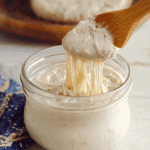How to Make Sourdough Starter
Making a sourdough starter from scratch is a simple process of fermenting flour and water to cultivate natural wild yeast and bacteria, which can be used to leaven bread without commercial yeast.
- Prep Time: 5 minutes daily
- Cook Time: 0 minutes
- Total Time: 5 days
- Yield: About 1 cup of starter 1x
- Category: How-To
- Method: Fermentation
- Cuisine: Global
- Diet: Vegan
Ingredients
Scale
- 2 cups all-purpose or whole wheat flour (divided)
- 2 cups filtered or dechlorinated water (divided)
Instructions
- Day 1: In a clean glass jar or container, mix 1/2 cup flour and 1/2 cup water. Stir thoroughly, cover loosely, and leave at room temperature (around 70°F/21°C).
- Day 2: You may see a few bubbles. Stir the mixture and let it rest again.
- Day 3: Discard half of the starter (about 1/2 cup), then feed it with 1/2 cup flour and 1/2 cup water. Stir and cover.
- Day 4: Repeat the discard and feeding process. By now, it should start to smell slightly sour and show more bubbles.
- Day 5: Continue discarding and feeding. The starter should double in size within 4–6 hours of feeding and have a yeasty, tangy smell—it’s ready to use!
- Store in the fridge if not baking daily. Feed at least once a week or before baking.
Notes
- Use non-chlorinated water to avoid killing the natural yeast.
- You can use rye or whole wheat flour to help jumpstart fermentation.
- If starter shows mold or smells rotten, discard and start over.
Nutrition
- Serving Size: 1 tablespoon
- Calories: 30
- Sugar: 0g
- Sodium: 0mg
- Fat: 0g
- Saturated Fat: 0g
- Unsaturated Fat: 0g
- Trans Fat: 0g
- Carbohydrates: 6g
- Fiber: 0g
- Protein: 1g
- Cholesterol: 0mg
Find it online: https://ukfinda.com/how-to-make-sourdough-starter/
